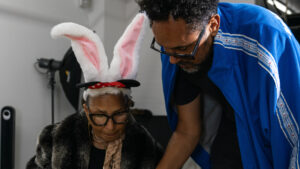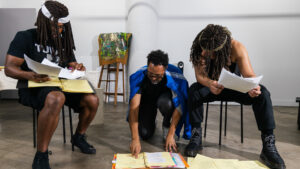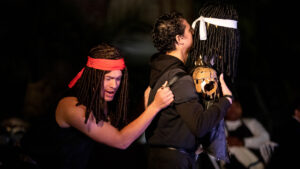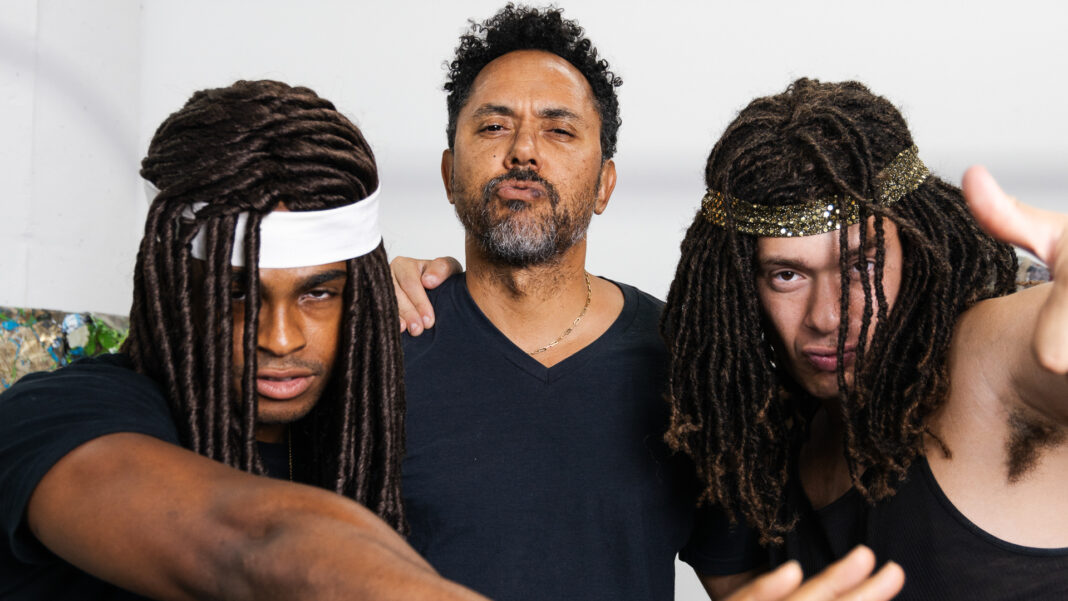
Frank Farian was the mastermind behind 1970’s group Boney M and the disgraced Grammy Award-winning duo Milli Vanilli. Walt Disney was head of his namesake studio that turned Joel Chandler Harris’ Tales of Uncle Remus into the film Song of the South (1946). Only in the inventive mind of artist/writer/director Edgar Arceneaux would these disparate stories find their way into a story about a matriarch battling dementia and how it impacts her two sons.
That’s the premise of Boney Manilli, which has its world premiere on October 5th at REDCAT in Los Angeles as part of CAP UCLA‘s 2023-2024 season. Boney Manilli runs through October 7th.
Arceneaux may be best known for his drawings, sculpture and installations. This very personal show of his, inspired by his late mother’s own battle with dementia, has been in the works for six years. Boney Manilli has burrowed into his psyche and in the process he’s found a way to examine our present-day world while finding a personal catharsis.
I recently spoke with Arceneuax about the combination of these stories, his own experiences with his mother and what it took for him to get all the pieces in place for Boney Manilli to work. What follows are excerpts from our conversation that have been edited for length and clarity. To see the full interview with Arceneaux, please go to our YouTube channel.
Q: Edgar Arceneaux, you told Caroline Goldstein for Artnet in 2020 that “The power of what art is, which is distinctive from other fields, is its unruliness, its nature to ask new questions.” Is that the guiding principle for you when you embark on any project? And if so, what was the principal question you wanted to ask with Boney Minilli?
Because its nature is to be interpreted, it means that each person’s individual perspective is important. That it’s in that space of differences, in that space of debate, where power comes from. Which is different than, say, an advertisement or maybe even an illustration which is meant to be instrumentalized. But I think that art’s power comes amidst its unwillingness to be fully turned into one meaning or one message.
In the case of Boney, confusion is part of that unruliness, and it’s confusion on two different sides. On one side is a writer/director that I named after myself, Edgar, who is struggling to write a play about Milli Vanilli. Every time he thinks he has it, then it slips away. At the same time he’s trying to take care of his mother, who is slowly dying from dementia and is forgetting everything.
There’s a brother in the middle of the story whose name is Bro Bro, and he’s the younger brother. He’s also trying to tell a story. But this one is centered around the Song of the South, the story that Walt Disney Studios made into a film. He’s convinced, and everyone else in the family is convinced, that that movie was actually written by their grandfather and that Disney stole it from them. So all of them are trying to tell the story before the mother passes away.
How often do you find ideas or projects that you’re doing slipping away from you? If you’re going to name the character after yourself, how much of you is in this?

Quite a bit. But there’s two different aspects of the character. There’s the one that’s struggling with the story and the frustration that comes along with that. But he’s struggling with the economic insecurity where he hopes that this thing is going to be able to get him out of the hole that he’s in. He’s living with his mother again.
Then there’s also the kind of madness that happens to people that can happen to you when you’re taking care of a loved one who’s going through either dementia or Alzheimer’s, because they go from being the person who’s there to nurture you to you becoming the person that nurtures them.
My mother and I had an amazing relationship up until the day that she passed. I did recognize in myself the capacity to become a really terrible person because of the emotional weight and responsibility. It just really tears and breaks everything apart when the mom is dealing with an illness.
In a podcast that UCLA Arts did with you a year ago when Boney Manilli was a work-in-progress, you talked about how these characters go through a baptism of fire. Have you been through a catharsis during the process of creating and bringing this show to life?
Most certainly. This is actually the fourth expression of this project over the last six years. This is the first one where I felt like I really could use the the aspects of how dementia impacts your mind as a kind of organizing principle for how to tell the story. When we did it as a work-in-progress presentation last March, it was impossible for me to really tell the story from that perspective because my mom had just passed away a year before. To go in three years after her passing, that can be a little more objective and a little more settled. The absolute reality, the undeniable reality, that she’s no longer physically here has given me a bit of creative distance to be able to really dig in to it in a way in which I just couldn’t do before.
I had this beautiful moment last night because I was with my dad. I had just taken him out to dinner and we were sitting on the bed. I finished a final edit of the script and I sent it to all the management team and the designers. I realized I was sitting on my mom’s side of the bed when I sent that final email off. It felt, in a subtle way, that there was something about it that was very poetic and I couldn’t have timed it that way.
Boney Manilli combines two problematic components of popular culture: Milli Vanilli and Song of the South, both of which have their own baggage that accompany them. What was the impetus for combining these two into one story?

I started to think about the relationship between these two stories: the one about the the potential death and then the way in which Joel Chandler Harris, the person who’s credited with these stories – actually just collected them from people who lived either on his plantation and of his grandfather or other Blacks who had these oral traditions – and then he created this character called Uncle Remus essentially in the same way that Rob and Fab existed as these fictional placeholders for a white author’s voice.
I recognized that these two stories are coming together, but I couldn’t leave those two things together without recognizing that there was a third element which was produced by juxtaposing these two things. Which is the way in which there is an industry of entertainment that values and monetizes this kind of trauma. The show is very critical of our desire to learn about the stories of people who’ve been taken advantage of.
And Frank Farian and Walt Disney both did that.
They did. But the lens of this show is very much focused on the appetite of the audience for these kinds of stories. So when you come and see it, you’ll see how we try to turn the camera from the stage to the audience. And it’s funny to me in some interesting ways.
CAP UCLA says, in laying out information about this show, “To paint the picture of identity and infamy within its true reality is Arceneaux’s artistry at its best.” We’re living in a time when identity is being discussed far more openly and with perhaps greater acceptance than it has in quite some time. But it’s going hand-in-hand with a culture via social media that allows us to manufacture our identity – which doesn’t necessarily have any basis in reality. What do you see as the present day reality of how we are looking at identity?
The question of how we see ourselves, how we label ourselves, goes hand-in-hand with with lens-based technologies that force us to quantify where we begin and where another person ends. I think the more pluralistic understanding of race, class, identity is really good for us as a republic. I do think that is butting up against the edges of grand monopolies and grand pooling of resources, both politically and economically, which is fortifying itself against this this desire for more of a plateau as opposed to giant pyramids of power. These things are pushing against each other. These monopolies are ways of reinforcing heteronormative ideas about ourselves.
Many artists are most excited about doing something that scares them. Was doing something like this show something that scared you?

A reason why I’ve been working on this project for six years is because the first three iterations were not great. I was sweating. It’s the worst feeling in the world to have an audience watching something of yours and you know that it’s not right. You’re just cringing on the inside because putting on these shows is so expensive. You’ve raised this money from other people [and] you want to do the best that you can. Sometimes you’re just not there and you just have to keep working at it. You have to keep faith that you’re going to get there. But there’s no indication that for certain you will.
Then at a certain point I was just like, Oh, I see the story now. I never could find the ending. I just couldn’t. I couldn’t write it for five years. And then I did.
After your mother’s funeral, you quoted her on social media. You said she said to you, “Just because my body ain’t here don’t mean I’m not still with you. I will always be two steps behind you, just right there when you need me.” How is your mother there with you through the creation and the rehearsals for Boney Manilli?
Oh, man. Yeah. I mean, that example of sitting on the bed with her last night is one example. She was a person who had an unyielding faith in me and my siblings. Oftentimes I would hear her voice or I can feel, some inkling that I was doing right by her in the story. After she passed I could feel her energy all around me, in me and the natural environment around me. I would often just rely upon that belief to stay grounded and keep the faith that this was going to be a great show.
To see the full interview with Edgar Arceneaux, please go here.
Main Photo: Two cast members of Boney Manilli with Edgar Arceneaux (Photo by Richard Ffrench/Courtesy CAP UCLA)










